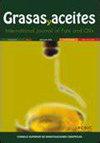Application of coconut fiber and shell in the bleaching of soybean oil
IF 1.1
4区 农林科学
Q4 CHEMISTRY, APPLIED
引用次数: 1
Abstract
The bleaching process is an important stage in the edible oil refining operation, and is carried out by using acid-activated bleaching earths. The aim of this study was to evaluate the efficiency of coconut fiber ash, shell ash, acid-activated fiber ash and acid-activated shell ash as compared to the commercial bleaching earth in the bleaching of neutralized soybean oil. Bleaching materials were added to neutralized oil at the concentration of 1% (w/v) with agitation under vacuum at 110 °C for 30 minutes. The values for red and yellow colors, carotenoids, chlorophylls, peroxide value, p-anisidine value, free fatty acid contents, copper and iron levels of the bleached samples were determined. The results indicated that all coconut-based adsorbents have been significantly more effective than commercial bleaching earth in reducing color and the greatest reductions in carotenoid (84.25%) and chlorophyll (82.30%) contents were obtained by using acid-activated fiber ash. The peroxide value for all treatments decreased. The amounts of iron and copper as peroxide compounds decreased considerably (44.59% and 23.53%) by using acid-activated fiber ash and acid-activated shell ash, respectively. Therefore, coconut fiber and shell as agricultural wastes which have been ignored in the past might be employed as effective agents to bleach crude oils, particularly soybean oil, in refining operations.椰子纤维和椰子壳在大豆油漂白中的应用
食用油漂白是食用油精制过程中的一个重要环节,采用酸活性漂白土进行。本研究的目的是评价椰子纤维灰分、壳灰分、酸活化纤维灰分和酸活化壳灰分在中和大豆油中的漂白效果,并与商业漂白土进行比较。将漂白材料加入到中和后的油中,浓度为1% (w/v),在110℃真空搅拌30分钟。测定了漂白后样品的红、黄颜色、类胡萝卜素、叶绿素、过氧化值、对茴香胺值、游离脂肪酸含量、铜、铁含量。结果表明,椰子基吸附剂的减色效果均明显优于商用漂白土,酸活性纤维灰分对类胡萝卜素和叶绿素含量的降低效果最大,分别为84.25%和82.30%。所有处理的过氧化值均降低。酸活化纤维灰分和酸活化壳灰分的过氧化物铁和铜含量分别显著降低(44.59%和23.53%)。因此,以往被忽视的农业废弃物椰子纤维和椰子壳可作为原油特别是大豆油漂白的有效剂,在炼油过程中加以利用。
本文章由计算机程序翻译,如有差异,请以英文原文为准。
求助全文
约1分钟内获得全文
求助全文
来源期刊

Grasas y Aceites
工程技术-食品科技
CiteScore
2.50
自引率
0.00%
发文量
50
审稿时长
3 months
期刊介绍:
Grasas y Aceites is a peer-reviewed journal devoted to the publication of original articles concerning the broad field of lipids, especially edible fats and oils from different origins, including non acyl lipids from microbial origin relevant to the food industry. It publishes full research articles, research notes, reviews as well as information on references, patents, and books.
Grasas y Aceites publishes original articles on basic or practical research, as well as review articles on lipid related topics in food science and technology, biology, (bio)chemistry, medical science, nutrition, (bio)technology, processing and engineering. Topics at the interface of basic research and applications are encouraged. Manuscripts related to by-products from the oil industry and the handling and treatment of the wastewaters are also welcomed.
Topics of special interest to Grasas y Aceites are:
-Lipid analysis, including sensory analysis
-Oleochemistry, including lipase modified lipids
-Biochemistry and molecular biology of lipids, including genetically modified oil crops and micro-organisms
-Lipids in health and disease, including functional foods and clinical studies
-Technical aspects of oil extraction and refining
-Processing and storage of oleaginous fruit, especially olive pickling
-Agricultural practices in oil crops, when affecting oil yield or quality
 求助内容:
求助内容: 应助结果提醒方式:
应助结果提醒方式:


